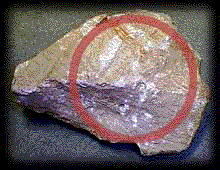 that are very explosive. Hot, frothy volcanic magma quickly cools,
leaving a structure of many twisted air holes inside. Pumice is thus very
light weight.
that are very explosive. Hot, frothy volcanic magma quickly cools,
leaving a structure of many twisted air holes inside. Pumice is thus very
light weight.
IntroductionA volcano is a location where magma, or hot melted rock from within a planet, reaches the surface. It may happen violently, in a massive supersonic explosion, or more quietly, as a sticky, slow lava flow.Volcanoes have been a part of earth's history long before humans. Compare the history of human beings, a few million years in the making, to that of the Earth, over four billion years in the making. Volcanoes were important contributors to the early earth atmosphere by releasing gases such as nitrogen (N2), carbon dioxide (CO2), and ammonia (NH4).
|
Pumice is one kind of rock formed by volcanic eruptions
 that are very explosive. Hot, frothy volcanic magma quickly cools,
leaving a structure of many twisted air holes inside. Pumice is thus very
light weight.
that are very explosive. Hot, frothy volcanic magma quickly cools,
leaving a structure of many twisted air holes inside. Pumice is thus very
light weight.
If you move your mouse over the image, you can see how pumice looks under the microscope.
A thin section is a layer of the rock cut so thin that the light from a microscope shines through, allowing us to see the structure of the rock.
The twisted chambers here represent the air pockets preserved inside
the rock when this rock blew out of a volcano.